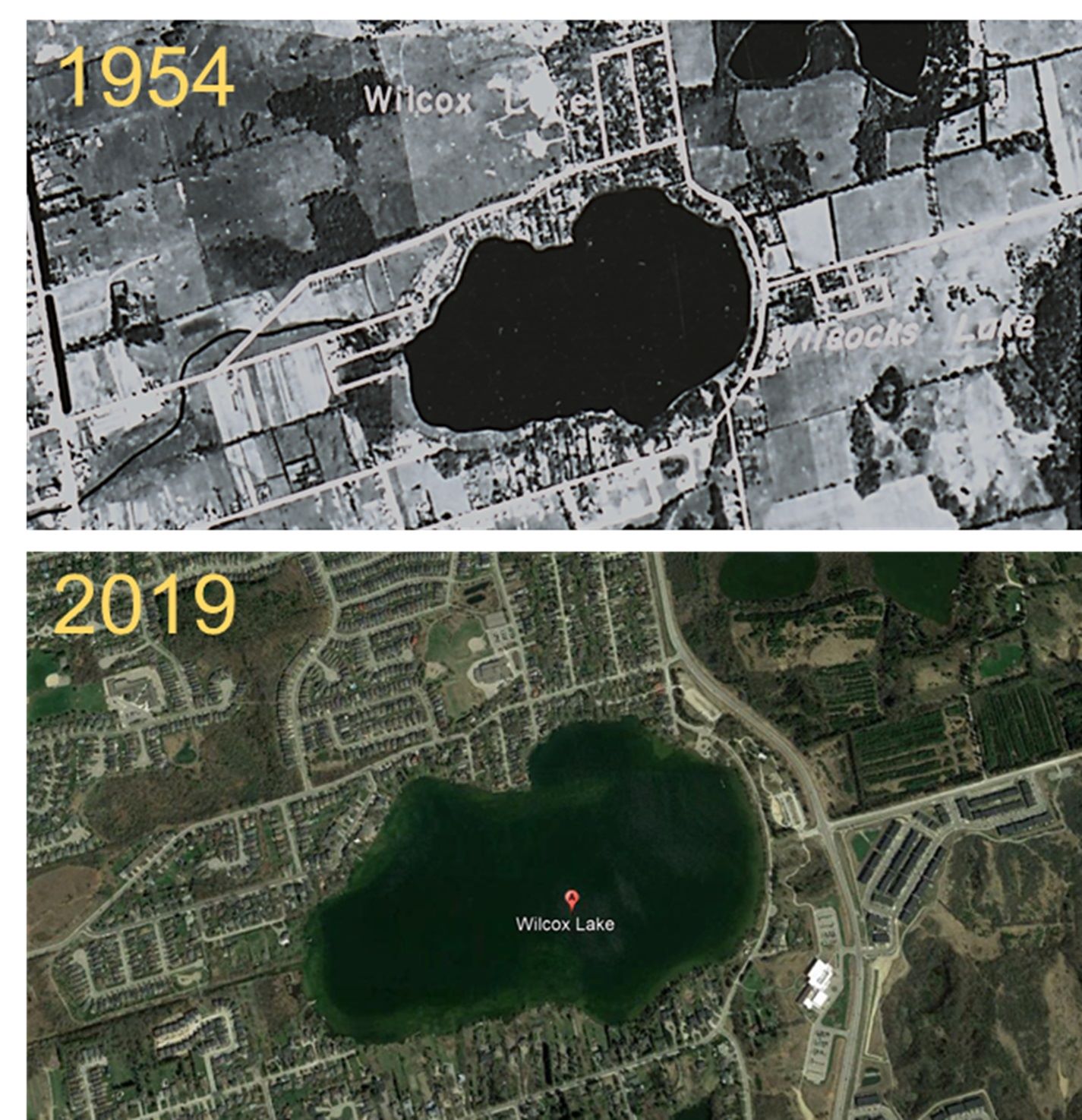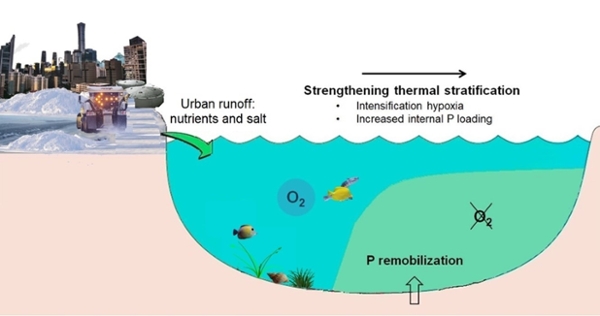From agriculture to urbanization: reconstructing a lake's changing water quality from sediment cores
Sediment cores reveal 100-year history of land use impacts on lake water quality.
By: Jovana Radosavljevic1, Stephanie Slowinski1, Fereidoun Rezanezhad1,2, and Philippe Van Cappellen1,2
1 Ecohydrology Research Group, Department of Earth and Environmental Sciences and Water Institute, University of Waterloo, Canada
2 Water Institute, University of Waterloo, Canada
 Lake Wilcox, one of the many kettle lakes in Ontario, has a story to tell. A story of how human activity – from the initial land clearing for farming over 100 years ago via shoreline cottage development to the current highly urbanized watershed - has impacted the lake’s water quality. The excessive algal growth and hypoxia (lack of oxygen in the water) of Lake Wilcox are raising growing demands by the local community to restore the lake’s ecological health. Using sediment core analyses, researchers in the Ecohydrology Research Group at the University of Waterloo have linked the evolving land use in the watershed to the resulting responses of the lake’s water quality. Their work relates changing land use practices to the historical trajectories of phosphorus enrichment, algae production, and the bottom water oxygen concentration of the lake.
Lake Wilcox, one of the many kettle lakes in Ontario, has a story to tell. A story of how human activity – from the initial land clearing for farming over 100 years ago via shoreline cottage development to the current highly urbanized watershed - has impacted the lake’s water quality. The excessive algal growth and hypoxia (lack of oxygen in the water) of Lake Wilcox are raising growing demands by the local community to restore the lake’s ecological health. Using sediment core analyses, researchers in the Ecohydrology Research Group at the University of Waterloo have linked the evolving land use in the watershed to the resulting responses of the lake’s water quality. Their work relates changing land use practices to the historical trajectories of phosphorus enrichment, algae production, and the bottom water oxygen concentration of the lake.
The paradigm for how land use drives excess growth of algae in a lake is through increasing the loading of nutrients, and especially that of phosphorus, from the lake’s watershed. Such high nutrient loadings are generally associated with runoff from agricultural landscapes which, in turn, stimulates algal growth and results in the depletion of oxygen in the deeper waters of the lake. The decreased bottom water oxygen concentration is caused by the high oxygen demand associated with the degradation of the sinking algal debris. Thus, in this widely accepted scenario for so-called lake eutrophication, the intensification of oxygen depletion is the direct consequence of increasing phosphorus loading from the watershed.
However, in a recent study from the Ecohydrology Research Group, a new culprit for eutrophication symptoms has emerged: urbanization-induced salinization. In this scenario, the intensification of bottom water oxygen depletion is linked to the lake’s salinization: increasing road salt runoff causes the water column salinity and water density to rise, which increasingly inhibits vertical mixing in the lake. As the bottom waters are then progressively becoming more isolated from the atmosphere, hypoxia expands.

 The researchers collected and studied sediment cores from the bottom of Lake Wilcox. The sediment cores represent historical archives of around 100 years of past sediment runoff from the surrounding land, as well as archives of algal growth, in-lake phosphorus cycling and bottom water oxygen levels. By analyzing the sediment’s compositional changes in parallel to historical records of land use and human settlement in the watershed, they were able to relate shifts in land use practices to changes in the lake’s phosphorus balance, algal productivity, and oxygenation. This research yielded a unique, holistic view of how human activities have impacted the ecological health of the lake. Most notably, the sediment core analyses helped uncover the relationships of urban growth in the watershed to Lake Wilcox’ progressive salinization, as well as to the unintended consequences for in-lake phosphorus recycling and hypoxia.
The researchers collected and studied sediment cores from the bottom of Lake Wilcox. The sediment cores represent historical archives of around 100 years of past sediment runoff from the surrounding land, as well as archives of algal growth, in-lake phosphorus cycling and bottom water oxygen levels. By analyzing the sediment’s compositional changes in parallel to historical records of land use and human settlement in the watershed, they were able to relate shifts in land use practices to changes in the lake’s phosphorus balance, algal productivity, and oxygenation. This research yielded a unique, holistic view of how human activities have impacted the ecological health of the lake. Most notably, the sediment core analyses helped uncover the relationships of urban growth in the watershed to Lake Wilcox’ progressive salinization, as well as to the unintended consequences for in-lake phosphorus recycling and hypoxia.
Lake Wilcox’s journey and water quality challenges mirror those of other freshwater lakes in cold temperate regions around the world. Increasing salt applications in urbanizing watersheds are enhancing eutrophication symptoms including oxygen depletion. In turn, the overall deteriorating water quality of the affected lakes reduces their habitability for aquatic life. The unexpected role played by road salt application is the effect on the mixing regime of the receiving lake, making it harder for the deeper waters to reoxygenate and, thus, causing the expansion of hypoxia. In contrast to the usual view that oxygen depletion is driven by the increase in the external phosphorus input to a lake, in this study, the authors show that worsening eutrophication symptoms are driven by salinization. Eutrophication and hypoxia are not just ecological problems – they affect people who enjoy their lakes for recreation or rely on them for their livelihoods.
Water managers need to address causes of salinization
 This research emphasizes that it is not just the runoff of phosphorus (and other nutrient elements, such as nitrogen) from the surrounding landscape that needs to be controlled if we want to keep our lakes healthy. Although implementing best management practices (BMPs), such as buffer strips or conservation tillage in agricultural areas or stormwater ponds in urban settings, can greatly reduce phosphorus loads to receiving lakes, to protect the health of lakes it is also crucial to address the causes of salinization.
This research emphasizes that it is not just the runoff of phosphorus (and other nutrient elements, such as nitrogen) from the surrounding landscape that needs to be controlled if we want to keep our lakes healthy. Although implementing best management practices (BMPs), such as buffer strips or conservation tillage in agricultural areas or stormwater ponds in urban settings, can greatly reduce phosphorus loads to receiving lakes, to protect the health of lakes it is also crucial to address the causes of salinization.
Communities can advocate for responsible salt use on roads and alternative solutions that help reduce salt inputs to surface water bodies and groundwater systems. Public pressure can motivate the implementation of integrated water management strategies that consider the cumulative impacts of multiple water quality stressors, including salinization, on our precious freshwater ecosystems.
By revealing the complex interplay between land use changes, phosphorus cycling, salinization, and hypoxia, this study helped advance the scientific understanding needed to guide the development of BMPs that enable a more harmonious relationship with our lakes and other freshwater resources. It underscores the need for sustainable practices in both rural and urban landscapes that promote a healthier coexistence between human activities and natural ecosystems.
Additional Reading & Resources
‘Forever contaminant’ road salts pose an icy dilemma: Do we protect drivers or our fresh water? - Conversation Canada (November 19, 2023)
Reducing road salt use 'not something that can wait' as Ontario lakes see oxygen depletion, researcher says - CBC News (November 26, 2023)
Philippe Van Cappellen: Road Salt - Superior Morning with Mary-Jean Cormier, CBC Radio (December 5, 2023)
Slowinski, S., Radosavljevic, J., Graham, A., Ippolito, I., Thomas, K., Rezanezhad, F., ... & Van Cappellen, P. (2023). Contrasting impacts of agricultural intensification and urbanization on lake phosphorus cycling and implications for managing eutrophication. Journal of Geophysical Research: Biogeosciences, 128(11), e2023JG007558. https://doi.org/10.1029/2023JG007558
